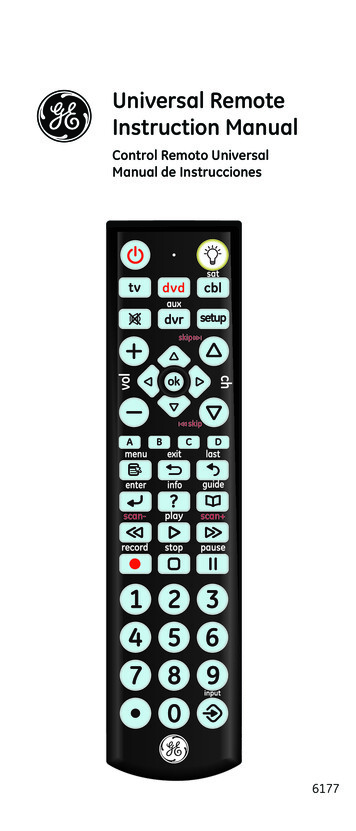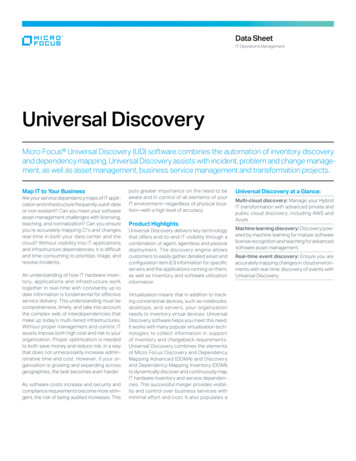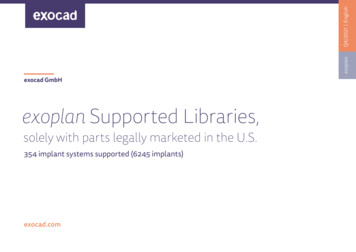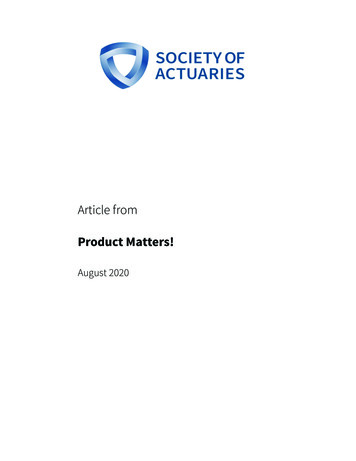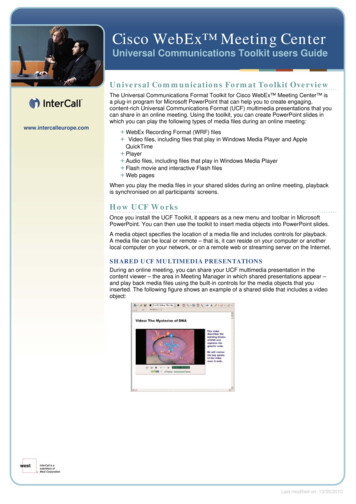
Transcription
GNUC: A New Universal Composability Framework Dennis Hofheinz†Victor Shoup‡December 11, 2012AbstractWe put forward a framework for the modular design and analysis of multi-party protocols.Our framework is called “GNUC” (with the recursive meaning “GNUC’s Not UC”), alreadyalluding to the similarity to Canetti’s Universal Composability (UC) framework. In particular,like UC, we offer a universal composition theorem, as well as a theorem for composing protocolswith joint state.We deviate from UC in several important aspects. Specifically, we have a rather differentview than UC on the structuring of protocols, on the notion of polynomial-time protocols andattacks, and on corruptions. We will motivate our definitional choices by explaining why thedefinitions in the UC framework are problematic, and how we overcome these problems.Our goal is to offer a framework that is largely compatible with UC, such that previousresults formulated in UC carry over to GNUC with minimal changes. We exemplify this bygiving explicit formulations for several important protocol tasks, including authenticated andsecure communication, as well as commitment and secure function evaluation.1IntroductionModular protocol design. The design and analysis of complex, secure multi-party protocolsrequires a high degree of modularity. By modularity, we mean that protocol components (i.e.,subprotocols) can be analyzed separately; once all components are shown secure, the whole protocolshould be.Unfortunately, such a secure composition of components is not a given. For example, while oneinstance of textbook RSA encryption with exponent e 3 may be secure in a weak sense, all securityis lost if three participants encrypt the same message (under different moduli), see [Hås88]. Furthermore, zero-knowledge proof systems may lose their security when executed concurrently [GK96].In both cases, multiple instances of the same subprotocol may interact in strange and unexpectedways.The UC framework. However, if security of each component in arbitrary contexts is proven,then, by definition, secure composition and hence modular design is possible. A suitable securitynotion (dubbed “UC security”) was put forward by Canetti [Can01], building on a series of earlierworks [GMW86, Bea92, MR92, Can00].Like earlier works, UC defines security through emulation; that is, a (sub)protocol is consideredsecure if it emulates an ideal abstraction of the respective protocol task. In this, one system Π First version: June 6, 2011; second version: Dec. 11, 2012 (improved exposition, improved modeling of staticcorruptions, no other definitional changes)†Karlsruhe Institute of Technology‡New York University; supported by NSF grant CNS-07166901
emulates another system F if both systems look indistinguishable in arbitrary environments, andeven in face of attacks. In particular, for every attack on Π, there should be a “simulated attack”on F that achieves the same results.Universal composition. Unlike earlier works, UC features a universal composition theorem(hence the name UC): if a protocol is secure, then even many instances of this protocol do not losetheir security in arbitrary contexts. Technically, if Π emulates an ideal functionality F, then we canreplace all F-instances with Π-instances in arbitrary larger protocols that use F as a subprotocol.This UC theorem has proven to be a key ingredient to modular analysis. Since the introductionof the UC framework in 2001, UC-compatible security definitions for most conceivable cryptographictasks have been given (see, e.g., [Can05] for an overview). This way, highly nontrivial existing (e.g.,[CLOS02, GMP 08]) and new (e.g., [Bar05, BCD 09]) multi-party protocols could be explainedand analyzed in a structured fashion. In fact, a security proof in the UC framework has becomea standard litmus test for complex multi-party computations. For instance, by proving that aprotocol emulates a suitable ideal functionality, it usually becomes clear what exactly is achieved,and against which kinds of attacks.The current UC framework. The technical formulation of the UC framework has changedover time, both correcting smaller technical bugs, and extending functionality. As an example ofa technical bug, the notion of polynomial runtime in UC has changed several times, because itwas found that earlier versions were not in fact compatible with common constructions or securityproofs (see [HUMQ09] for an overview). As an example of an extension, the model of computation(and in particular message scheduling and corruption aspects) in UC has considerably evolved.For instance, earlier UC versions only allowed the atomic corruption of protocol parties; the mostrecent public UC version [Can05] allows a very fine-grained corruption of subprotocol parts, whileleaving higher-layer protocols uncorrupted.Issues in the UC framework. In the most recent public version UC05 [Can05], the UC framework has evolved to a rather complex set of rules, many of which have grown historically (e.g., thecontrol function, a means to enforce global communication rules). As we will argue below, this hasled to a number of undesirable effects.Composition theorem. As a first example, we claim that, strictly speaking, the UC theoremitself does not hold in UC05. The reason has to do with the formalization of the compositionoperation, i.e., the process of replacing one subprotocol with another. In UC05, the compositionoperation replaces the code of an executed program party-internally, without changing even theinterface to the adversary. Hence, an adversary may not even know which protocol a party isrunning.However, during the proof of the composition theorem, we have to change exactly those partsof the adversary that relate to the replaced subprotocol instances. Because there is no way for theadversary to tell which program a party runs, it is hence not clear how to change the adversary.We give a more detailed description of in §11.2, along with a counterexample, which we brieflysketch here (using traditional UC terminology).We start with a one-party protocol Π0 that works as follows. It expects an initialization messagefrom the environment Z, which it forwards to the adversary A. After this, it awaits a bit b fromA, which it forwards to Z.We next define a protocol Π01 , which works exactly the same as Π0 , except that upon receipt ofthe bit b from A, it sends 1 b to Z.2
We hope that the reader agrees that Π01 emulates Π0 in the UC05 framework. Indeed, thesimulator A0 , which is attacking Π0 , uses an internal copy of an adversary A01 that is supposed tobe attacking Π01 . When A01 attempts to send a bit b to Π01 , A0 instead sends the bit 1 b to Π0 . Wethink that this is not a quirk of the UC05 framework — in fact, we believe that Π01 should emulateΠ0 in any reasonable UC framework.So now consider a one-party protocol Π that works as follows. Π expects an initial messagefrom Z, specifying a bit c; if c 0, it initializes a subroutine running Π0 , and if c 1, it initializesa subroutine running Π01 . However, the machine ID assigned to the subroutine is the same in eithercase. When Π receives a bit from its subroutine, it forwards that bit to Z.The composition theorem says that we should be able to substitute Π01 for Π0 in Π, obtaining aprotocol Π1 that emulates Π. Note that in Π1 , the subroutine called is Π01 , regardless of the valueof c. However, it is impossible to build such a simulator — intuitively, the simulator would have todecide whether to invert the bit, as in A0 , or not, and the simulator simply does not have enoughinformation to do this correctly.In any fix to this problem, the adversary essentially must be able to determine not only theprogram being run by a given machine, but also the entire protocol stack associated with it, inorder to determine whether it belongs to the relevant subprotocol or not.Trust hierarchy. Next, recall that UC05 allows very fine-grained corruptions. In particular,it is possible for an adversary to corrupt only a subroutine (say, for secure communication withanother party) of a given party. In this, each corruption must be explicitly “greenlighted” bythe protocol environment, to ensure that the set of corrupted parties does not change duringcomposition. Specifically, this explicit authorization step prevents a trivial simulation in which theideal adversary corrupts all ideal parties.We claim that the UC05 corruption mechanism is problematic for two reasons. First, usually theset of (sub)machines in a real protocol and in an ideal abstraction differ. As an example, think of aprotocol that implements a secure auction ideal functionality, and in the process uses a subprotocolfor secure channels. The real protocol is comprised of at least two machines per party (one for themain protocol, one for the secure channels subprotocol). However, an ideal functionality usuallyhas only one machine per party. Now consider a real adversary that corrupts only the machinethat corresponds to a party’s secure channels subroutine. Should the ideal adversary be allowedto corrupt the only ideal machine for this party? How should this be handled generally? In thecurrent formulation of UC05, this is simply unclear. (We give more details and discussion aboutthis in §11.3.)Second, consider the secure auctions protocol again. In this example, an adversary can impersonate a party by only corrupting this party’s secure channels subroutine. (All communication isthen handled by the adversary in the name of the party.) Hence, for all intents and purposes, sucha party should be treated as corrupted, although it formally is not. This can be pushed further:in UC05, the adversary can actually bring arbitrary machines (i.e., subroutines) into existence bysending them a message. There are no restrictions on the identity or program of such machines; onlyif a machine with that particular identity already exists is the message relayed to that machine. Inparticular, an adversary could create a machine that communicates with other parties in the nameof an honest party before that party creates its own protocol stack and all its subroutines. Thishas the same effect as corrupting the whole party, but without actually corrupting any machine.(See §11.3 for more details.)Polynomial runtime. Loosely speaking, UC05 considers a protocol poly-time when all machines run a number of steps that is polynomial in the difference between the length of theirrespective inputs minus the length of all inputs passed down to subroutines. This implies that theabstract interface of a protocol must contain enough input padding to propagate runtime through3
all necessary subprotocols of an implementation. In particular, this means that formally, the interface of an ideal protocol must depend on the complexity of the intended implementation. Thiscomplicates the design of larger protocols, which, e.g., must adapt their own padding requirementsto those of their subprotocols. Similar padding issues arise in the definition of poly-time adversaries.This situation is somewhat unsatisfying from an aesthetic point of view, in particular since suchpadding has no intuitive justification. We point out further objections against the UC05 notion ofpolynomial runtime in §11.7.None of the objections we raise point to gaps in security proofs of existing protocols. Rather,they seem artifacts of the concrete technical formulation of the underlying framework.GNUC. One could try to address all those issues directly in the UC framework. However, thiswould likely lead to an even more complex framework; furthermore, since significant changes to theunderlying communication and machine model seem necessary, extreme care must be taken thatall parts of the UC specification remain consistent. For these reasons, we have chosen to developGNUC (meaning “GNUC’s not UC”, and pronounced g-NEW-see) from scratch as an alternativeto the UC framework. In GNUC, we explicitly address all of the issues raised with UC, while tryingto remain as compatible as possible with UC terminology and results.Before going into details, let us point out our key design goals:Compatibility with UC. Since the UC issues we have pointed out have nothing to do withconcrete security proofs for protocols, we would like to make it very easy to formulate existing UCresults in GNUC. In particular, our terminology is very similar to the UC terminology (although thetechnical underpinnings differ). Also, we establish a number of important UC results (namely, theUC theorem, completeness of the dummy adversary, and composition with joint state) for GNUC.We also give some example formulations of common protocol tasks. Anyone comfortable in usingUC should also feel at home with GNUC.Protocol hierarchy. We establish a strict hierarchy of protocols. Every machine has anidentity that uniquely identifies its position in the tree of possible (sub)protocols. Concretely, anymachine M 0 invoked by another machine M has an identity that is a direct descendant of that ofM . The program of a machine is determined by its identity, via a program map, which maps themachine’s identity to a program in a library of programs. Replacing a subprotocol then simplymeans changing the library accordingly. This makes composition very easy to formally analyze andimplement. Furthermore, the protocol hierarchy allows to establish a reasonable corruption policy(see below).Hierarchical corruptions. Motivated by the auction example above, we formulate a basicpremise:if any subroutine of a machine M is corrupt, then M itself should be viewed as corrupt.In particular, if a subroutine is corrupted that manages all incoming and outgoing communication,then the whole party must be viewed as corrupt. This translates to the following corruptionpolicy: in order to corrupt a machine, an adversary must corrupt all machines that are above thatmachine in the protocol hierarchy. Since our adversary cannot spontaneously create machines (asin UC), this completely avoids the “hijacking” issues in UC explained above. Furthermore, whenwe compare a real and an ideal protocol, real corruptions always have ideal counterparts. (If thereal adversary corrupts a subroutine, it must have corrupted the corresponding root machine in thehierarchy; at least this root machine must have an ideal counterpart, which must now be corruptedas well.)4
Polynomial runtime. Our definition of polynomial runtime should avoid the technical pitfallsthat led to current UC runtime definition. At the same time, it should be convenient to use, withoutunnatural padding conventions (except, perhaps, in extreme cases). A detailed description can befound in our technical roadmap in §2. However, at this point we would like to highlight a niceproperty that our runtime notion shares with that of UC05. Namely, our poly-time notion is closedunder composition, in the following sense: if one instance of a protocol is poly-time, then manyinstances are as well. Furthermore, if we replace a poly-time subprotocol Π0 of a poly-time protocolΠ with a poly-time implementation Π01 of Π0 , then the resulting protocol is poly-time as well.(While this sounds natural, this is not generally the case for other notions of poly-time such as theone from [HUMQ09].)Other related work. Several issues in the UC framework have been addressed before, sometimesin different protocol frameworks. In particular, the issues with the UC poly-time notion werealready recognized in [HMQU05, Küs06, HUMQ09]. These works also propose solutions (in differentprotocol frameworks); we comment on the technical differences in §11.7, §11.8, and §11.9. The UCissues related to corruptions have already been recognized in [CCGS10].Besides, there are other protocol frameworks; these include Reactive Simulatability [BPW07],the IITM framework [Küs06], and the recent Abstract Cryptography [MR11] framework. Wecomment on Reactive Simulatability and the IITM framework in §11.9 and §11.8. The AbstractCryptography framework, however, focuses on abstract concepts behind cryptography and has notyet been fully specified on a concrete machine level.2RoadmapIn this section, we give a high-level description of each of the remaining sections.Section 3: machine modelsIn this section, we present a simple, low-level model of interactive machines (IMs) and systems ofIMs. Basically, a system of IMs is a network of machines, with communication based on messagepassing. Execution of such a system proceeds as a series of activations: a machine receives amessage, processes it, updates its state, and sends a message to another machine.Our model allows an unbounded number of machines. Machines are addressed by machine IDs.If a machine sends a message to a machine which does not yet exist, the latter is dynamicallygenerated. A somewhat unique feature of our definition of a system of IMs is the mechanism bywhich the program of a newly created IM is determined. Basically, a system of IMs defines a libraryof programs, which is a finite map from program names to programs (i.e., code). In addition, thesystem defines a mapping from machine IDs to program names. Thus, for a fixed system of IMs, amachine’s ID determines its program.Section 4: structured systems of interactive machinesOur definition of a system of IMs is extremely general — too general, in fact, to effectively modelthe types of systems we wish to study in the context of universal composition of protocols. Indeed,the definitions in §3 simply provide a convenient layer of abstraction. In §4, we define in great detailthe notion of a structured system of IMs, which is a special type of system of IMs with restrictionsplaced on machine IDs and program behaviors. Technically, these restrictions can be enforced by“sandboxing” machines: we consider machines structured as an arbitrary inner core running inside5
a sandbox that ensures that all restrictions are met. We give here a brief outline of what theserestrictions are meant to provide.In a structured system of IMs, there are three classes of machines: environment, adversary, andprotocol. There will only be one instance of an environment, and only one instance of an adversary,but there may be many instances of protocol machines, running a variety of different programs.Protocol machines have IDs of the form h pid , sid i. Here, pid is called a party ID (PID) and sidis called a session ID (SID). Machines with the same SID run the same program, and are consideredpeers. The PID serves to distinguish these peers. Unfortunately, the term “party” carries a numberof connotations, which we encourage the reader to ignore completely. The only meaning that shouldbe applied to the term “party” is that implied by the rules regarding PIDs. We will go over theserules shortly.We classify protocol machines as either regular or ideal. The only thing that distinguishes thesetwo types syntactically is their PID: ideal machines have a special PID, which is distinct from thePIDs of all regular machines. Regular and real machines differ, essentially, in the communicationpatterns that they are allowed to follow. An ideal machine may communicate directly (with perfectsecrecy and authentication) with any of its regular peers, as well as with the adversary.A regular machine may interact with its ideal peer, and with the adversary; it may not interactdirectly with any of its other regular peers, although indirect interaction is possible via the idealpeer. A regular machine may also pass messages to subroutines, which are also regular machines.Subroutines of a machine M may also send messages to M , their caller.Two critical features of our framework are that regular machines are only created by beingcalled, as above, and that every regular machine has a unique caller. Usually, the caller of a regularmachine M will be another regular machine; however, it may also be the environment, in whichcase, M is a “top level” machine. The environment may only communicate directly with suchtop-level regular machines, as well as with the adversary.Another feature of our framework is that the SID of a regular machine specifies the nameof the program run by that machine, and moreover, the SID completely describes the sequenceof subroutine calls that gave rise to that machine. More specifically, an SID is structured as a“pathname”, and when a machine with a given pathname calls a subroutine, the subroutine sharesthe same PID as the caller, and the subroutine’s SID is a pathname that extends the pathname ofthe caller by one component, and this last component specifies (among other things) the programname of the subroutine.One final important feature of our framework is that the programs of regular machines must“declare” the names of the programs that they are allowed to call as subroutines. These declarationsare strictly enforced at run time.Execution of such a system proceeds as follows. First, the environment is activated. After this,as indicated by the restrictions described above, control may pass between the environment and a top-level regular machine, a regular machine and its ideal peer, a regular machine and its caller, a regular machine and one of its subroutines, the adversary and the environment, or the adversary and protocol machine (regular or ideal).6
We close this section with the definition of the dummy adversary (usually denoted by Ad ). Thisis a specific adversary that essentially acts as a “wire” connecting the environment to protocolmachines.Section 5: protocolsThis section defines what we mean by a protocol. Basically, a protocol Π is a structured system ofIMs, minus the environment and adversary. In particular, Π defines a map from program names toprograms. The subroutine declarations mentioned above define a static call graph, with programnames as nodes, and with edges indicating that one program may call another. The requirementis that this graph must be acyclic with a unique node r of in-degree 0. We say that r is the root ofΠ, or, alternatively, that Π is rooted at r.We then define what it means for one protocol to be a subprotocol of another. Basically, Π0 is asubprotocol of Π if the map from program names to programs defined by Π0 is a restriction of themap defined by Π.We also define a subprotocol substitution operator. If Π0 is a subprotocol of Π, and Π01 is anotherprotocol, we define Π1 : Π[Π0 /Π01 ] to be the protocol obtained by replacing Π0 with Π01 in Π. Thereare some technical restrictions, namely, that Π0 and Π01 have the same root, and that the substitutionitself does not result in a situation where one program name has two different definitions.Observe that protocol substitution is a static operation performed on libraries, rather than arun-time operation.We also introduce some other terminology.If Z is an environment that only calls regular protocol machines running programs named r,then we say that Z is multi-rooted at r. In general, we allow such a Z to call machines with variousSIDs, but if Z only calls machines with a single, common SID, then we say that Z is rooted at r.If Π is a protocol rooted at r, A is an arbitrary adversary, Z is an environment multi-rooted atr, then these programs define a structured system of IMs, denoted by [Π, A, Z].If Z is rooted at r, then during an execution of [Π, A, Z], a single instance of Π will be running;if Z is multi-rooted at r, then many instances of Π may be running. During the execution of sucha system, it is helpful to visualize its dynamic call graph. The reader may wish to look at Fig. 2on p. 24, which represents a dynamic call graph corresponding to two instances of a two-partyprotocol. In this figure, circles represent regular protocol machines. Rectangles represent idealprotocol machines, which are connected to their regular peers via a dotted line. In general, adynamic call graph of regular machines will be a forest of trees, where the roots are the top-levelmachines that communicate directly with the environment.Section 6: resource boundsThe main goal of this section is to define the notion of a polynomial time protocol.When we define a polynomial time algorithm, we bound its running time as a function ofthe length of the input. For protocols that are reacting to multiple messages coming from anenvironment (either directly or via the dummy adversary), we shall bound the running time of allthe machines comprising the protocols as a function of the total length of all these messages.To this end, we only consider environments Z that are well-behaved in a technical sense definedin this section. Intuitively, an environment Z is well behaved if it runs in time polynomial inthe length of all of its incoming messages, and the total length of messages emanating from it isbounded by a polynomial in security parameter.7
ZfepΠfeafapAFigure 1: FlowsThe execution of a system [Π, A, Z] will be driven by such a well-behaved environment Z. Therunning time of the protocol will be bounded by the length of various flows: fep is the flow from Z into Π; fea is the flow from Z into A; fap is the flow from A into Π.By flow, we mean the sum of the lengths of all relevant messages (including machine IDs andsecurity parameter). To define the notion of a poly-time protocol, we do not need the flow fap , butthis will come in handy later. See Fig. 1 for an illustration. We stress that in this figure, the boxlabeled Π represents all the running protocol machines.Let us also define tp to be the total running time of all protocol machines running in theexecution of [Π, A, Z], and ta to be the total running time of A in this execution.Our definition of a poly-time protocol runs like this: we say a protocol Π rooted at r is(multi-)poly-time if there exists a polynomial p such that for every well-behaved Z (multi-)rootedat r, in the execution of [Π, Ad , Z], we havetp p(fep fea )with overwhelming probability. Recall that Ad denotes the dummy adversary. Since Ad is essentiallya “wire”, observe that fap is closely related to fea .Two points in this definition deserve to be stressed: (i) the polynomial p depends on Π, but noton Z; (ii) the bound is required to hold only with overwhelming probability, rather than probability1. We also stress that in bounding the running time of Π, we are bounding the total running timeof all machines in Π in terms of the total flow out of Z — nothing is said about the running timeof an individual machine in terms of the flow into that machine.This definition is really two definitions in one: poly-time (for “singly” rooted environments) andmulti-poly-time (for “multiply” rooted environments). The main theorem in this section, however,states that poly-time implies multi-poly-time.Section 7: emulationAt the heart of any framework for universal composition is a notion of emulation. Very informally,one says that a protocol Π1 emulates another protocol Π if for every attack on Π1 , there is asimulator that attacks Π, so that these two attacks are indistinguishable — the idea is that inthis way, Π1 acts as a “secure implementation” of Π. More formally, the definition says that forevery adversary A1 , there exists an adversary A, such that Exec[Π, A, Z] Exec[Π1 , A1 , Z] for8
all environments Z. Here, Exec[Π, A, Z] represents the output (which is generated by Z) of theexecution of the system [Π, A, Z], and “ ” means “computationally indistinguishable”. Also, wequantify over all well-behaved environments Z, rooted at the common root of Π and Π1 ; if weallow multi-rooted environments, we say that Π1 multi-emulates Π, and otherwise, we say that Π1emulates Π.In the above definition, we still have to specify the types of adversaries, A and A1 , over whichwe quantify. Indeed, we have to restrict ourselves to adversaries that are appropriately resourcebounded.Recall the above definitions of flow and running time, namely, fep , fea , fea , tp , and ta . SupposeΠ is a protocol rooted at r. We say that an adversary A is (multi-)time-bounded for Π if there existsa polynomial p, such that every well-behaved environment Z (multi-)rooted at r, in the executionof [Π, A, Z], we havetp ta p(fep fea )with overwhelming probability. We also say that A is (multi-)flow-bounded for Π if there exists apolynomial p, such that every well-behaved environment Z (multi-)rooted at r, in the execution of[Π, A, Z], we havefap p(fea )with overwhelming probability.So in our definition of emulation, we restrict ourselves to adversaries that are both (multi-)timebounded and (multi-)flow-bounded — we call such adversaries (multi-)bounded. The timeboundedness constraint should seem quite obvious and natural. However, the flow-boundednessconstraint may seem somewhat non-obvious and unnatural; we shall momentarily discuss why it isneeded, some difficulties it presents, and how these difficulties may be overcome.It is easy to see that if Π is (multi-)poly-time, then the dummy adversary is (multi-)bounded forΠ. So we always have at least one adversary to work with that satisfies our constraints — namely,the dummy adversary — and as we shall see, this is enough.We state here the main theorems of this section.Theorem 5 (completeness of the dummy adversary) Let Π and Π1 be (multi-)poly-timeprotocols rooted at r. Suppose that there exists an adversary A that is (multi-)bounded for Π,such that for every well-behaved environment Z (multi-)rooted at r, we have Exec[Π, A, Z] Exec[Π1 , Ad , Z]. Then Π1 (multi-)emulates Π.Theorem 6 (emulates multi-emulates) Let Π and Π1 be poly-time protocols. If Π1emulates Π, then Π1 multi-emulates Π.Recall that if a protocol is poly-time, then it is also multi-poly-time, so the statement of Theorem 6 makes sense. Because of these properties, we ignore multi-emulation in the remaining twotheorems.Theorem 7 (composition theorem) Suppose Π is a poly-time protocol rooted at r. Suppose Π0is a poly-time subprotocol of Π rooted at x. Finally, suppose Π01 is a poly-time prot
We hope that the reader agrees that 0 1 emulates 0in the UC05 framework.Indeed,the simulator A0, which is attacking 0, uses an internal copy of an adversary A0 1 that is supposed to be attacking 0 1.When A01attempts to send a bit bto 0 1, A0instead sends the bit 1 bto 0.We think that this is not a quirk of the UC05 framework in fact, we believe that 0 1 should emulate


